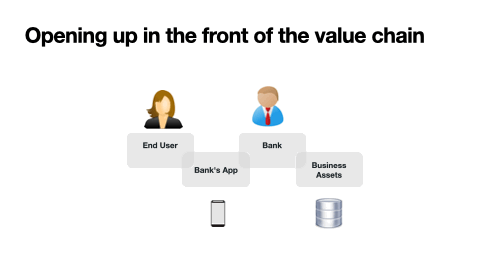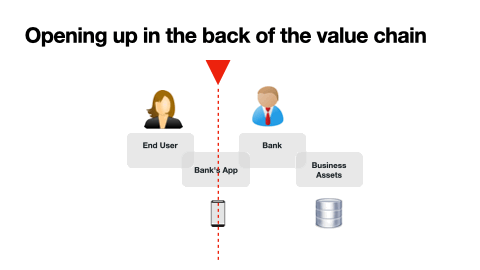How open banking APIs reshape the value chain
Learn how open banking reshapes the value chain with APIs, making it possible to adapt to changing customer needs and to keep customers happy.


APIs are revolutionizing the financial services industry by making core banking functionality, such as accounts, transactions, balances and payments, digitally and programmatically available – both inside the organization and outside to third parties.
This is the foundation of open banking. But open banking is more than just the technical APIs in the financial space alone, it also provides the security, legal and regulatory context necessary to transform financial services and reshape the value chain.
How does open banking reshape the value chain? By opening up the traditional value chain of financial services and make it more broadly accessible.
Often it is believed that there is only one way to open up the value chain – in the front, where banks need to provide APIs for fintechs to use. But this is only half the story. As we highlight in this post, there is also the possibility for banks to open up in the back of the value chain, allowing banks to use APIs of others and be on the consuming end.
So, there are at least two possibilities to open the value chain: In the front, where banks are API providers, or in the back, where banks are API consumers.
Let’s look into each of these options.
Opening up in the FRONT end of the value chain
Traditionally, a bank delivers its own apps and end-user-facing technology. Instead of (or in addition to) that, the bank may become an API provider and deliver APIs to its products (accounts, transactions, balances, payments, loans). These APIs are used by fintechs and other third parties, in the role of API consumers. They build end-user-facing apps that call the APIs of the bank.
Moreover, in their apps fintechs integrate, orchestrate and aggregate the bank’s APIs with APIs of their own and from other players. The resulting apps are provided to end-users, who are typically also customers of the bank. Value flows from the banks via the fintechs to the end-users and compensation opportunities also exist in the opposite direction.


An example use case for opening up the value chain in the front is a multibanking app offered by a fintech that aggregates data from several bank accounts. The fintech gets transaction data and balances or all of the customer’s bank accounts, via APIs offered by those banks. Even though customers seldom see the API, they will appreciate that they can see their banks’ account in their favorite multibanking app – thanks to open banking APIs.
When banks open up their value chain in the front, the value chain gets longer and moves left, as you can see in Image 1. In this scenario, banks need to be good at exposing APIs, securing APIs, marketing their APIs and building partnerships.
Opening up the BACK end of the value chain
Open banking also allows banks to open up the back end of their value chain. This allows banks to offer – via their own channels – banking products that are actually provided by other players. The bank simply uses the API provided by the other player. The bank does not need to build product functionality in its systems, nor does it need to hold the data in its systems. Instead, the bank simply takes on the role of an API consumer, uses the API, and thus integrates the banking product into its UIs and channels.


An example use case for opening up the value chain in the back is a bank that wants to start offering unsecured loans as part of its own product portfolio – something this bank has not offered before. Instead of creating the unsecured loan product in-house, the bank uses the unsecured loan product from a fintech via API. By opening up the back end of its value chain, the bank can fill the gap in its portfolio quickly. With a short time-to market it can start offering unsecured loans to its customer base via its own channel.
When banks open up their value chain in the back, the value chain moves right, as can be seen in Image 2. The value chain now extends out to an external API provider. When opening up the back of the value chain, banks need to focus on new capabilities and skills, such as consuming, orchestrating and integrating third-party APIs. Moreover, they need to be good at building eye-level partnerships with fintech companies.
Conclusion
As we have seen, banks not only have the possibility to change the structure of their value chain but also find value in doing so. Thanks to open banking, APIs and API integration, banks have more choice than ever to change the structure of their value chain, and this helps them to adapt to changing customer needs and to keep their customers happy.
More choices in structuring the value chain also bring more responsibility to banks to make smart choices. In my next post, I will discuss how banks need to think strategically when opening up their banking stack.